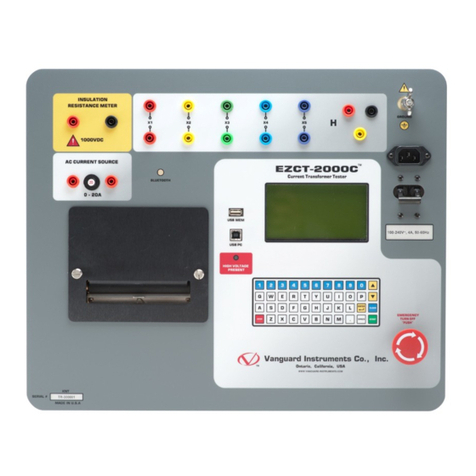
REV 1 CBCT USER’S MANUAL
2
1.0 INTRODUCTION
1.1 General Description and Features
The Vanguard Circuit Breaker Coil Tester (CBCT) is a variable voltage DC power supply designed
specifically to test substation circuit-breaker Open and Close coils. The CBCT uses the
substation’s DC power supply to electronically generate a programmable output voltage from
5% to 95% of the source voltage. The CBCT can maintain up to an 80A test current while
maintaining 2% or better voltage regulation during the circuit breaker coil operation. The CBCT
provides a safe and convenient method for testing minimum operating voltages of Open and
Close coils.
The CBCT provides one pulse and one continuous DC output. The unit’s built-in short-circuit
protection feature protects the coil under test if the current exceeds 80 amperes or if the
current drawing duration is more than 500 milli-seconds. A general purpose single channel
timer is also available for checking circuit breaker operating time or for any other timing
application.
Input Voltage
The CBCT’s input voltage range is from 20 to 300 Vdc. The input circuit is also protected from a
reversed polarity connection.
Output Voltage
The output voltage is programmable from 5% to 95% of the input voltage and is set using the
dial on the front panel. Output voltage regulation is better than 2% under load. Two DC outputs
are available on the CBCT. The continuous DC output is capable of sourcing current up to 40
amperes. The pulse DC output is capable of sourcing up to 80 amperes for up to 500 milli-
seconds. Both outputs are protected against short-circuit conditions if the test current exceeds
80 amperes or if the drawing duration is more than 500 milli-seconds.
CBCT Status Display
The CBCT features a back-lit LCD screen (20 characters by 4 lines) that is viewable in both bright
sunlight and low-light levels. The input and output voltages are displayed on the screen during
testing. If a power supply fault condition occurs, a red “FAULT” LED light is illuminated on the
front panel and a corresponding message is displayed on the LCD screen.
CBCT Timer
The built-in, single channel timer can be used to verify circuit-breaker timing parameters or for
any timing application. The timing range is from 0.000 to 999.000 seconds with an accuracy of
0.1 milli-seconds. The timing results are displayed in both milli-seconds and cycles. The timer
can be started by circuit-breaker coil initiation or can be triggered by the dry or wet contact
input. The timer can be stopped by either the dry or wet contact input.





























